ISIS carried out at least 11 confirmed attacks in September in the Homs, Hama, Raqqa, and Deir Ez Zor governorates. These attacks killed at least 11 pro-Assad regime soldiers and seven civilians and wounded at least four additional soldiers and one civilian. There were also four high quality* attacks during September. ISIS activity in central Syria decreased in September following one of the most violent months of the year in August. However, like in August, nearly all of the documented attacks in September occurred in Deir Ez Zor and southern Raqqa. Militants were able to carry out several significant attacks, including capturing a regime military position, establishing a fake checkpoint, and attempting (but ultimately failing) to ambush a military convoy. Documented ISIS activity in southern Raqqa has steadily increased since June. September matched a nine-month record for attacks in Raqqa and followed local claims in August that ISIS cells had established numerous checkpoints throughout the desert for extortion and levying taxes against local traders.
Despite the lower number of attacks in September compared to August, ISIS continued to maintain an aggressive posture. At least seven of the 11 documented attacks were conducted with small or medium arms, while only two attacks used mines or Improvised Explosive Devices (IED). The apparent confidence with which ISIS cells conducted operations over the past two months stands in stark contrast with the militants’ posture during the past two years, focusing more on using mines, IEDs or distant harassing attacks in order to avoid Russian air support and a heavy regime security presence. However, regime forces have this year returned to their 2019 and 2020 practice of often transporting soldiers in small, unguarded bus convoys that are highly vulnerable to attacks, while Russian and Syrian airpower has been increasingly rare. Compounding this vulnerability is the recent conflict between Russian mercenary group Wagner and the Russian Ministry of Defense (MoD), culminating in the death of Wagner leader Yevgeny Prigozhin on August 23. Since then, the Wagner forces that played a key role in establishing defensive lines and leading offensives against ISIS in central Syria have gradually withdrawn from the region. According to multiple credible sources, Wagner forces have withdrawn from the Shoula area of western Deir Ez Zor, (their only permanent presence in Deir Ez Zor) and as of late September had fully withdrawn from the Sukhnah area of Homs.
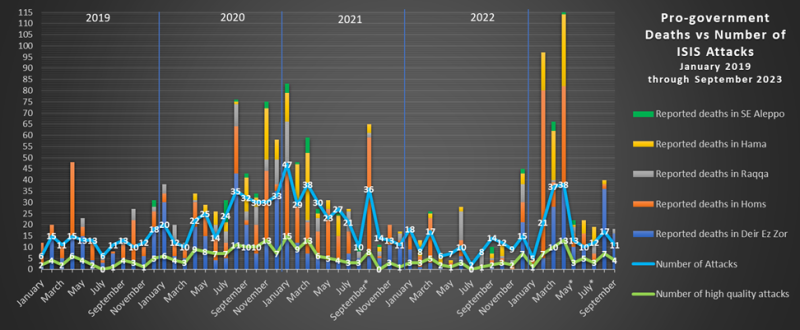
ISIS attacks dropped in Deir Ez Zor (5), Homs (1) and Hama (1) while doubling in southern Raqqa (4).
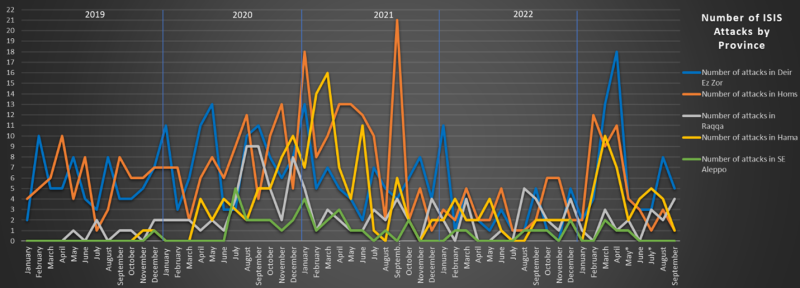
Deir Ez Zor and Raqqa
The number of ISIS attacks in Deir Ez Zor in April (18) was unprecedented, more than in any month since the beginning of the insurgency in 2018. There was a dramatic reversal in activity in May (4), June (3), and July (3) followed by another surge in activity in August (8). Throughout this period, ISIS cells began targeting regime security forces inside the urban centers along the Euphrates River. However, ISIS activity in Deir Ez Zor dropped again in September, and attacks appeared to be concentrated more in the west Deir Ez Zor region around Shoula.
A regime soldier was killed in Deir Ez Zor on each of September 8 and 9, although the exact location and means of death were not reported. Also on September 9, ISIS militants attacked a group of shepherds and their guards south of Shoula. At least seven shepherds, one local Liwa al-Quds fighter, and two local National Defense Forces fighters were killed in the attack. Local militiamen who ventured into the countryside in search of the stolen sheep after the attack hit a mine or IED, leaving one dead and between one and three men wounded. On September 11, ISIS militants killed three local guards in a nighttime attack on the outskirts of the Kharrata Oil Field, northwest of Deir Ez Zor City.
In southern Raqqa, locals reported throughout August that ISIS cells had established fake checkpoints in the Mansoura and Resafa regions, which they used to extort money from shepherds and local traders. This author was informed of at least one of these checkpoints operating on August 15 near Mansoura. This type of brazen ISIS activity continued through September. On September 13, ISIS militants attacked regime forces northwest of the Zamla Gas Field. On September 21, two soldiers were killed and at least two wounded in an ISIS attack on their position west of Resafa. Three days later, an ISIS cell captured and looted a regime position in an early morning operation near the Bir Rahum hamlet on the southern Raqqa border. On September 26, an ISIS cell set up a fake checkpoint near Resafa using stolen uniforms and flags of the regime’s 5th Corps (potentially captured in the September 24 Bir Rahum attack) but reportedly fled when they were identified by security forces.
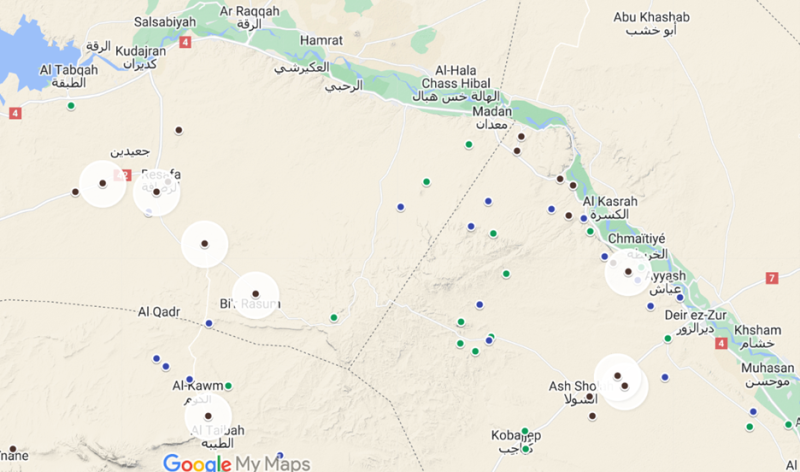
Homs and Hama
Confirmed ISIS activity continues to be muted in eastern Homs since the end of the month-long battles around al-Kawm village in April. However, the aforementioned withdrawal of Wagner forces from the Sukhnah sector will likely result in ISIS renewing pressure on this front in the near future. The only confirmed ISIS attack in Homs occurred on September 10 when militants attacked a regime transport south of al-Kawm, though no soldiers died or were wounded in the ambush.
Attacks in Hama dropped for the second month in a row, with only one incident documented in September. On September 27, a mine exploded, wounding a 13-year-old child outside the village of Um Miyal.
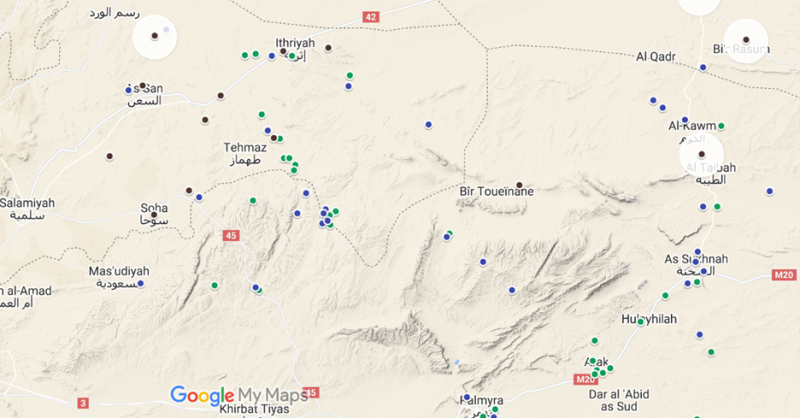
Looking Ahead
The withdrawal of Wagner forces from much of the Badia over the past month will likely be the defining factor for ISIS’s insurgency across much of central Syria in the near term. Wagner forces have reportedly been replaced by Iranian advisers from the Islamic Revolutionary Guard Corps (IRGC) and foreign and Syrian militias under their control. The question now is whether these units will be as effective as Wager fighters have been during the past two years at fending off major ISIS pushes into the strategic centers around Sukhnah, such as al-Kawm and Wadi Doubayat, and around the Shoula region of Deir Ez Zor.
Compounding this question is the past month’s fighting in eastern Deir Ez Zor, in the region controlled by the U.S.-backed Syrian Democratic Forces (SDF). Locals, mostly from the Akidat, Bakir, and Shaytat tribes, rose up against the SDF there at the end of August. While the SDF was able to quickly retake the dozens of towns that had initially expelled their security forces, a robust anti-SDF insurgency appears to have already taken hold. This area was already a hot bed for ISIS cells, which had exploited a weak security presence and deep animosity between locals and the Kurdish-run administration, to build an expansive financial, recruitment, and insurgent network. The Syrian regime has also spent the past several years building its own insurgent network in the region—though it has remained far smaller and weaker than ISIS’s. The evolution of anti-SDF sentiment into action by locals has likely opened the door for both ISIS and regime cells to expand their activity. Here it should be emphasized that most locals in Deir Ez Zor are staunch opponents of the regime. However, the general degradation of security networks combined with some locals turning to armed insurgency will inevitably create openings for either active or unwitting cooperation between ISIS, regime, and tribal cells.
Given the chaotic nature of the unfolding events in eastern Deir Ez Zor, it is unclear exactly how ISIS will utilize its resources (it is worth noting that the group explicitly denounced the tribal uprisings in one of its weekly al-Naba publications shortly after the fighting began). ISIS still has limited resources to work with and has, over the past years, had to move men between regime- and SDF-held regions depending on the viability of the operating environments. Now the group will likely have to weigh the costs and benefits of trying to exploit the withdrawal of Wagner in eastern Homs and the crisis in eastern Deir Ez Zor, while continuing its high level of activity in southern Raqqa.
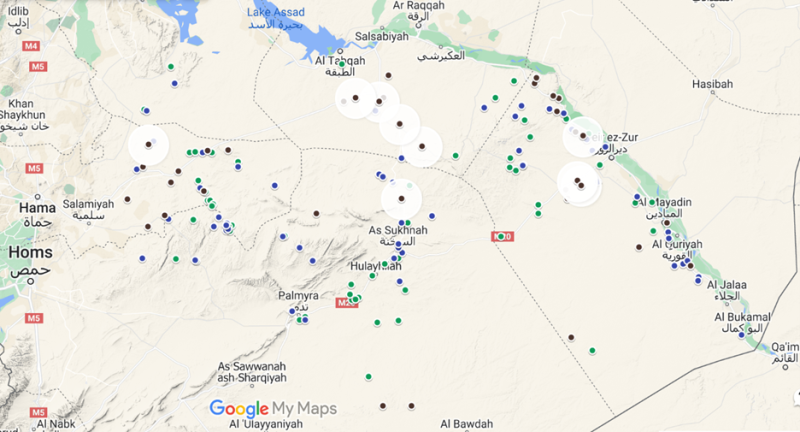
*High quality attacks are defined as attacks behind frontlines, those that result in seized positions, target regime officers, involve coordinated attacks on multiple positions, fake checkpoints, ambushes on military convoys, or attacks on checkpoints that kill at least three soldiers or lead to POWs.
 Eurasia Press & News
Eurasia Press & News

